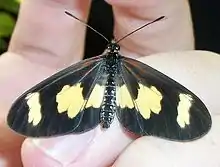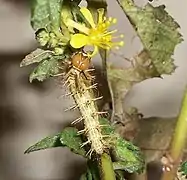Acraea cabira
Acraea cabira, the yellow-banded acraea, is a butterfly of the family Nymphalidae that is native to Africa.

| Yellow-banded acraea | |
|---|---|
 | |
| Male | |
| Scientific classification | |
| Kingdom: | Animalia |
| Phylum: | Arthropoda |
| Class: | Insecta |
| Order: | Lepidoptera |
| Family: | Nymphalidae |
| Genus: | Acraea |
| Species: | A. cabira |
| Binomial name | |
| Acraea cabira Hopffer, 1855 | |
| Synonyms | |
| |
Description
The wingspan is 38–44 mm (1.5–1.7 in) for males and 40–45 mm (1.6–1.8 in) for females.[1] The male and female are very similar in colour. The upper surface of the wings is near black with large yellow patches on the forewing and hindwing. There is some reddish brown on the veins near the base of the forewings. The underside has patches of yellow corresponding to the upperside. The base of the undersurface of the wing has orange-brown markings with black spots. The margin of the wing on the undersurface has black lines on an orange-brown background.[2]
Distribution
It is found from the eastern subtropical forest areas of South Africa, through Swaziland, Zimbabwe,[2] and to Uganda, the Congo and Kenya.[3]
Life cycle
Larvae
The larvae feed on Triumfetta (including T. tomentosa), Hemannia, Hibiscus and Cephalomma species. When young, they group together on a mass of silk that they spin on the food plant, but as they grow older they venture out alone to different parts of the food plant.
Pupae
The pupae have a whitish to yellowish background with two rows of yellow and black markings down the back, but the pupa becomes dark coloured close to hatching. The wing areas have fine black veining on a whitish to yellowish background, but the black and yellow wings show through the shell of the pupa near hatching.
Gallery
 A mass of young larvae on the food plant
A mass of young larvae on the food plant Larva eating flower of Triumfetta sp.
Larva eating flower of Triumfetta sp. Pupa viewed from the back, with shed caterpillar skin on the left
Pupa viewed from the back, with shed caterpillar skin on the left A female pupa viewed from the side, a few hours before hatching
A female pupa viewed from the side, a few hours before hatching A pair mating in captivity (female at the top of the picture)
A pair mating in captivity (female at the top of the picture)
Taxonomy
Acraea cabira is a member of the Acraea bonasia species group; see Acraea.
References
- Woodhall, Steve (2005). Field Guide to Butterflies of South Africa. Cape Town, South Africa: Struik. ISBN 978-1-86872-724-7.
- Williams, M. (1994). Butterflies of Southern Africa; A Field Guide. ISBN 1-86812-516-5.
- "Acraea Fabricius, 1807" at Markku Savela's Lepidoptera and Some Other Life Forms
- Bernaud & Pierre, 2007. - Acraea cabira, A. sotikensis et espèces voisines. Révision et premiers états. Lambillonea, CVII, 1bis, supplément II, Mai 2007: 1-14
| Wikispecies has information related to Acraea cabira. |
| Wikimedia Commons has media related to Acraea cabira. |
External links
- Die Gross-Schmetterlinge der Erde 13: Die Afrikanischen Tagfalter. Plate XIII 56 c as cabira , apecida and natalensis
- Images representing Acraea cabira at Bold